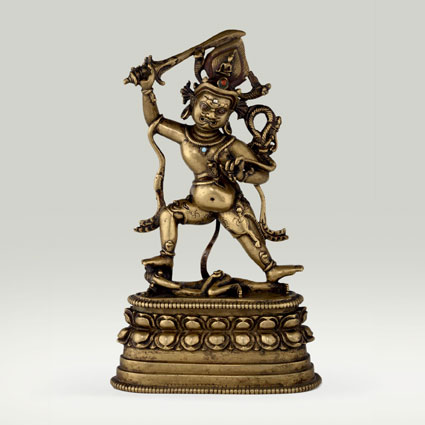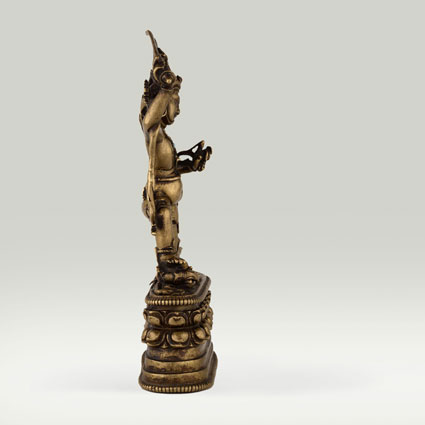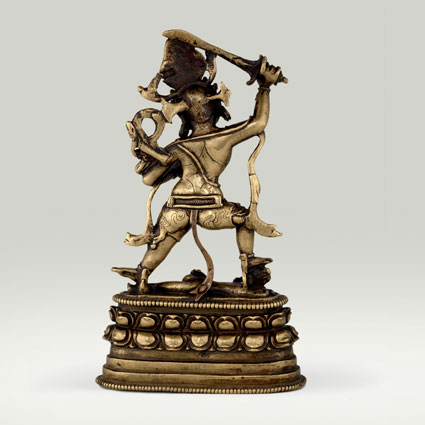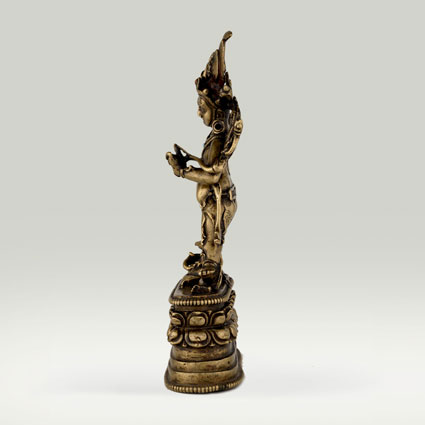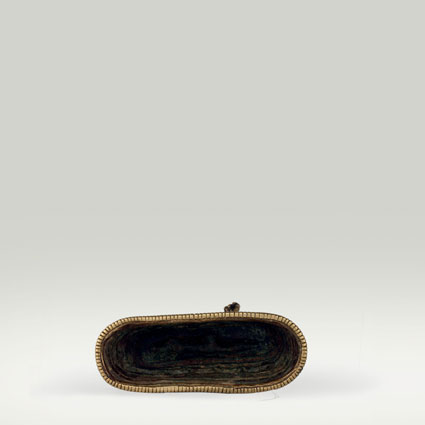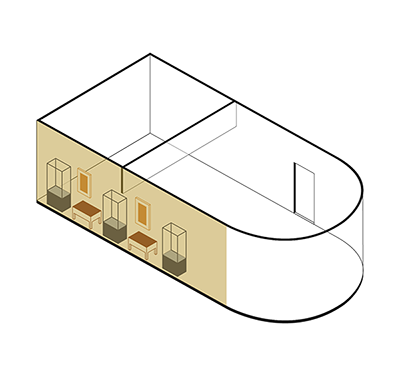ABS 036
Code: ABS 036
Country: Tibet (central)
Style: Late Pala Style
Date: 1200 - 1300
Dimensions in cm WxHxD: 14.1 x 23.5 x 5.5
Materials: Brass
The image is extensively inlaid with ‘silver’ and copper and decorated with engraved ornaments.
The necklace is inset with a turquoise and the central panel of the crown has an empty setting.
The hair has traces of a red pigment, which is an indication that this image was earlier under worship in Tibet. T
he bottom of the pedestal is not sealed.
The fearful two-eyed form of Nila Acala or “blue Acala” (Tib. Mi gyo ba sngon po) is trampling on the defeated Ganesa laid upon a double lotus pedestal and holding in the right hand an alms bowl (patra). Acala is stepping to the right with the right leg bent and the left straight (pratyalidhasana). He brandishes in the right uplifted hand the sword (khadga), and holds with the left hand, displayed in the gesture of threatening (tarjani-mudra), the end of the large noose (pasa) with a large loop attached to the left shoulder. Acala is sparsely dressed with a tiger skin (vyaghracarma) tied below the protruding belly. He is decorated with jewelled ornaments, namely with a five fold small crown in front of the prominent knot of hair with a small effigy of Aksobhya, a pair of circular earrings and a necklace with an attached pendant. The bracelets, the “investiture with the sacred thread” (nagopavita) and the anklets are composed of snake emblems. The image wears a ribbon-like scarf around the shoulders with the swirling ends hanging down on both sides. The cloth hanging down between the legs increases the stability of the image. The name Acala means “mountain” or literally “immobile”, and he is always shown in fearsome attitude and represents one of the ten Khroda protector deities in various Mandalas.
The Sadhanamala (SM), Nispannayogavali (NSP), Kryasamgraha (KS) and the Pindikrama-Sadhana (PKS) contain descriptions of several forms of Acala (Tib. Mi gyo ba): SM 86–87, 211–12; NSP 1–3, 11, 20, 26; KS 2; PKS 175–78. Acala is known in the Sanskrit literature under various different names such as Candacala, Candamaharosana, Mahacandarosana (SM 85–88), Kekara (SM 212) or Vajrabhisana (NSP 11, KS 2). In this publication all standing forms of Acala, regardless whether trampling on Ganesa or not are classified as Nila Acala (“Blue Acala”) (Tib. Mi gyo ba sngon po). The kneeling forms of Acala are classified as Sita Acala or “white Acala” (Tib. Mi gyo ba dkar po). Both forms can have two or three eyes.
Also known as Acalanatha, Aryacalanatha, Acala-vidya-raja and Candamaharosana. In Vajrayana Buddhism, Acala (alternatively, Achala or Acala) is the best known of the Five Wisdom Kings of the Womb Realm. Acala means "The Immovable One" in Sanskrit. Acala is also the name of the eighth of the ten stages of the path to buddhahood.
Acala is the destroyer of delusion and the protector of Buddhism. His immovability refers to his ability to remain unmoved by carnal temptations. Despite his fearsome appearance, his role is to aid all beings by showing them the teachings of the Buddha, leading them into self-control.
He is seen as a protector and aide in attaining goals. Temples dedicated to Acala perform a periodic fire ritual in devotion to him.
The buddha Akshobhya, whose name also means “the immovable one”, is sometimes merged with Acala. However, Acala is not a buddha, but one of the Five Wisdom Kings of the Womb Realm in Vajrayana as found in the Indo-Tibetan tradition, as well as the Japanese Shingon sect of Buddhism. As 'Fudo myo-o', Acala is considered one of the Thirteen Buddhas in Japan
Iconography
Acala is typically depicted with a sword for subduing demons in his right hand and a rope for catching and binding them in his left hand. He has a fearsome blue visage and is surrounded by flames, representing the purification of the mind. He is often depicted seated or standing on a rock to show his immovability. His hair commonly has seven knots and is draped on his left side, a servant hairstyle in Buddhist iconography. He is frequently depicted with two protruding fangs. One tooth points down, representing his compassion to the world, and one tooth points up, representing his passion for truth.
Béguin, Gilles, 2013. Art sacré du Tibet – Collection Alain Bordier, [catalogue of the exhibition held at the Fondation Pierre Bergé – Yves Saint Laurent; 14 mars au 21 juillet 2013]. Paris: Fondation Pierre Bergé – Yves Saint Laurent. Editions Findakli.
Chandra, Lokesh, 1991. Buddhist Iconography of Tibet (CBIT). New Delhi: International Academy of Indian Culture & Aditya Prakashan. nos. 13, 187, 202, 322, 682-687, 775, 934-935, 2377 (174), 2422 (219) - References to the iconography of Acala
Cornu, Philippe , 2001. Dictionnaire Encyclopédique du Bouddhisme. Seuil. Pp. 33-34
de Mallmann, Marie-Thérèse, 1963. “Notes d’iconographie tântrique: III. A propos du Fudô bleu [Acala]”, Arts Asiatiques. Tome IX, Fasc. 1–2. EFEO, Musée Guimet. Pp. 73-79, fig 1 - References to the iconography of Acala
de Mallmann, Marie-Thérèse, 1964. Étude iconographique sur Manjusri. Paris: École Française d’Extrème-Orient. Pp. 16, 30, 32, 70-71, 111-112, 128-32 - References to the iconography of Acala
de Mallmann, Marie-Thérèse, 1975. Introduction à l'iconographie du tântrisme bouddhique. Paris: Adrien Mainsonneuve (Jean Maisonneuve successeur (1970). Pp. 83-85 - References to the iconography of Acala
Frédéric, Louis, 1992. Les Dieux du Bouddhisme. Guide iconographique . Paris: Flammarion. P. 201 sq. - Sur l'iconographie d'Acala
Heller, Amy, 1999. Tibetan Art Tracing the Development of Spiritual Ideals and Art in Tibet 600-2000 A.D.. Jaca Books.
Huntington, John C.; Bangdel, Dina und Arvidsson, Björn (Traduction), 2010. Le Cercle de la Félicité. Art Méditatif Bhouddhique. «The cercle of Bliss. Buddhist meditational Art».. Genève: Duo Visual.
Rambach, Pierre, 1978. Le Bouddha secret du tantrisme japonais. Genève: Skira . Sur l'iconographie d'Acala
von Schroeder, Ulrich, 2001. Buddhist Sculptures in Tibet. Vol. One: India & Nepal; Vol. Two: Tibet & China. Hong Kong: Visual Dharma Publications, Ltd.. Pp. 1038-1039, 1112-1113; Pls. 259, 291 - Compare with other images of Acala

